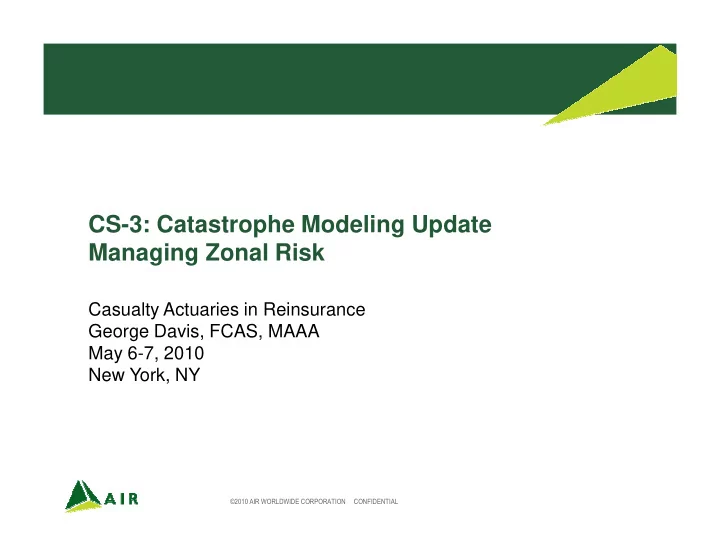

CS-3: Catastrophe Modeling Update Managing Zonal Risk Casualty Actuaries in Reinsurance George Davis, FCAS, MAAA May 6-7, 2010 New York, NY ������������������������������������������������
Introduction • The highest wind speed and often the most intense damage from hurricanes occurs at the coast • The footprint of storm damage often extends far inland • There is significant exposure and thus loss potential from inland exposure • Some companies focus heavily on managing exposure in coastal counties, not paying sufficient attention to inland risk 2 ������������������������������������������������
About 17 Percent of U.S. Industry Exposure is in Atlantic and Gulf Coastal Counties Estimated 2007 Insured Value of Coastal Properties by State ($B) 3 ������������������������������������������������
The Proportion of Coastal Exposure is Similar for Residential and Commercial Lines of Business 4 ������������������������������������������������
Georgia: Significant Inland Risk 5 ������������������������������������������������
2004 and 2005 Claims Data Clearly Show Inland Loss Potential 6 ������������������������������������������������
AIR Hurricane Model Realistically Captures Inland Residential and Commercial Losses Commercial Ground Up Loss Cost Residential Ground Up Loss Cost 7 ������������������������������������������������
About 5 to 10 Percent of All Hurricanes Go Through Re-intensification 8 ������������������������������������������������
Lessons from Ike: Requirements for a Robust Model Inland states are modeled Track durations extended based on HURDAT Rmax evolves along the inland track 9 ������������������������������������������������
Though Exposure is High in Coastal Areas, Significant Accumulation of Loss Can Occur Inland Estimated Ground Up Industry Loss Ike Opal Katrina Tier A 1 19.5% 76.7% 32.7% Tier B 2 55.2% 2.8% 52.9% Tier C 3 3 12.1% 17.3% 11.6% Tier D 4 13.1% 3.2% 2.7% Tier E 5 n/a n/a n/a 1 Zip codes whose zip code centroids are within 1 mile of the effective coastline 2 Counties which touch the effective coastline, excluding Tier A areas 3 Coastal states, excluding Tier A and B areas 4 Inland HU states, Excluding Tier A, B and C areas (includes MO, IL and IN) 5 Remainder of country 10 ������������������������������������������������
Importance of Knowing Policy Conditions – Storm Surge High-Risk Zones Storm Surge Risk using AIR US Hurricane Model 11 ������������������������������������������������
Modeled Loss Estimates are Highly Sensitive to Proper Coding of Policy Conditions Data coded to indicate which Unknown percentage of High percentage of policies policies cover storm surge policies covering storm surge covering storm surge �������������� ���!� � ��"���#$���$����%� ��������� ���������� ��������� ���������� ��������� !���%&��'�%���� 45.00 3.5 300 40.00 40.00 3 3 35.00 250 2.5 30.00 200 Losses 25.00 2 Losses Losses 150 20.00 1.5 15.00 100 1 10.00 50 0.5 5.00 0 0.00 0 Properly Coded high Properly Coded high Properly Coded high Company A Company B Company C AIR Real-time Ike Scenario (Low Portfolio Loss) AIR Real-time Ike Scenario (High Portfolio Loss) Actual Portfolio Loss Experience Source: Hurricane Ike: Performance of the AIR Model 12 ������������������������������������������������
Summary • There is significant inland hurricane risk • There is significant loss potential from storm surge • Exposure aggregation should extend beyond coastal counties • Using Catastrophe models with quality data provides a • Using Catastrophe models with quality data provides a more robust view of risk and is the best approach to understanding catastrophe risk 13 ������������������������������������������������
Recommend
More recommend